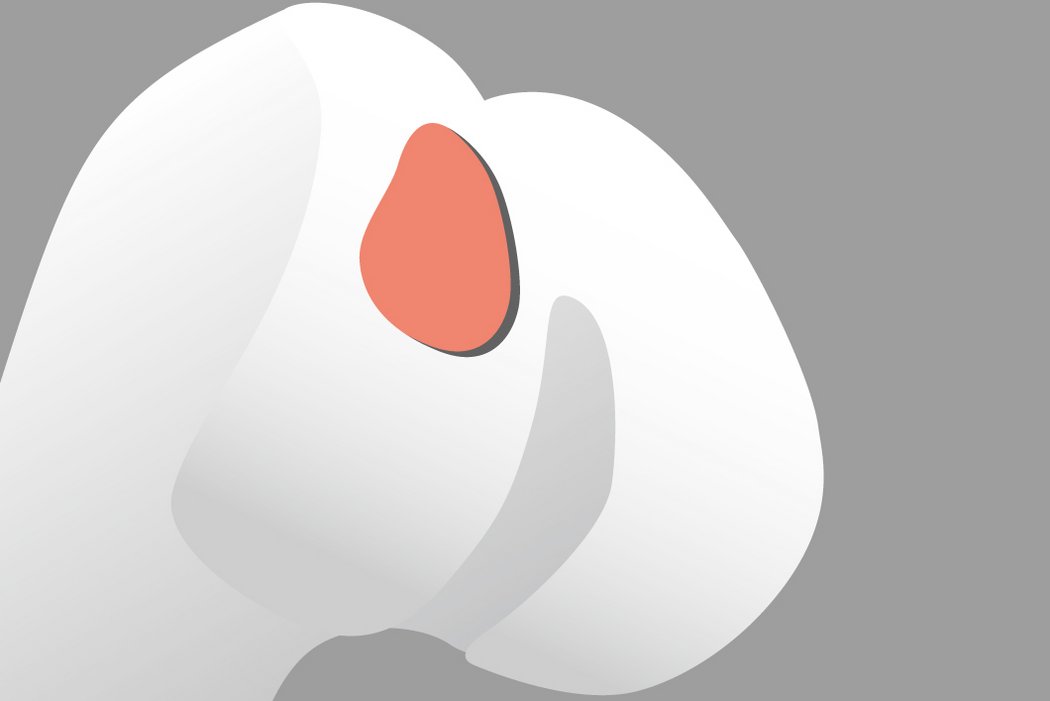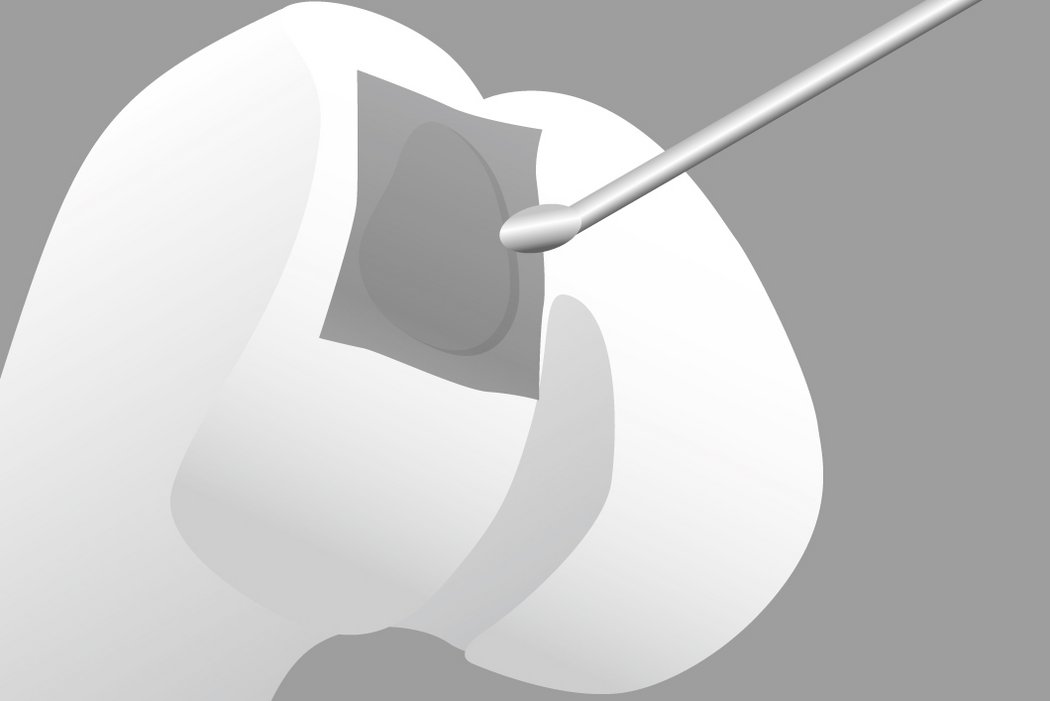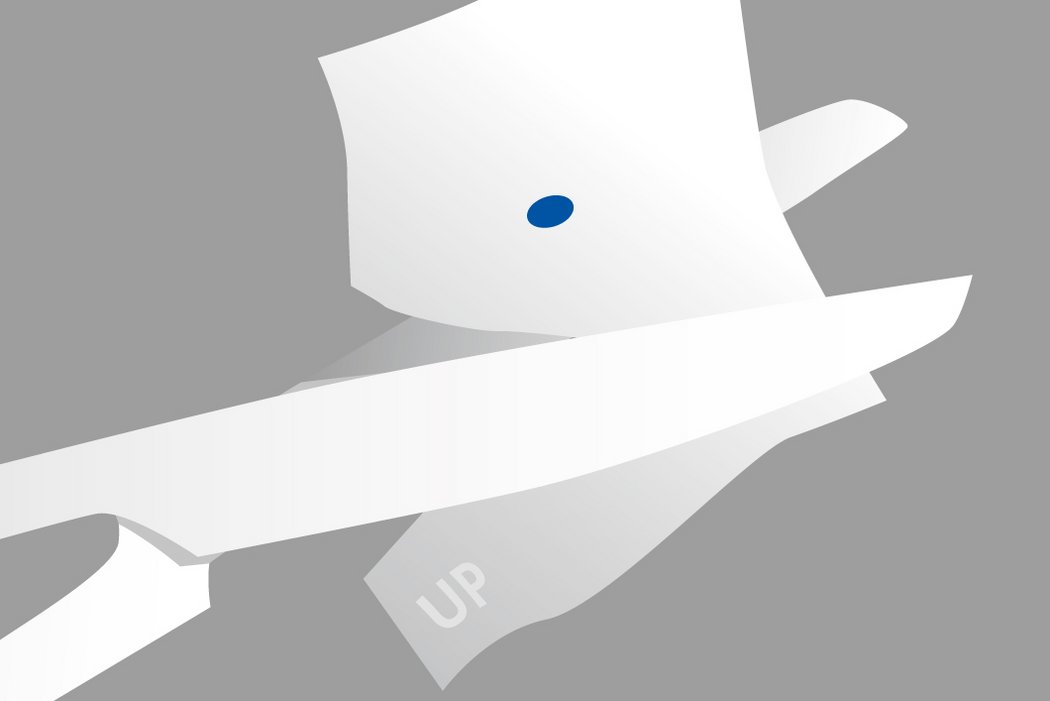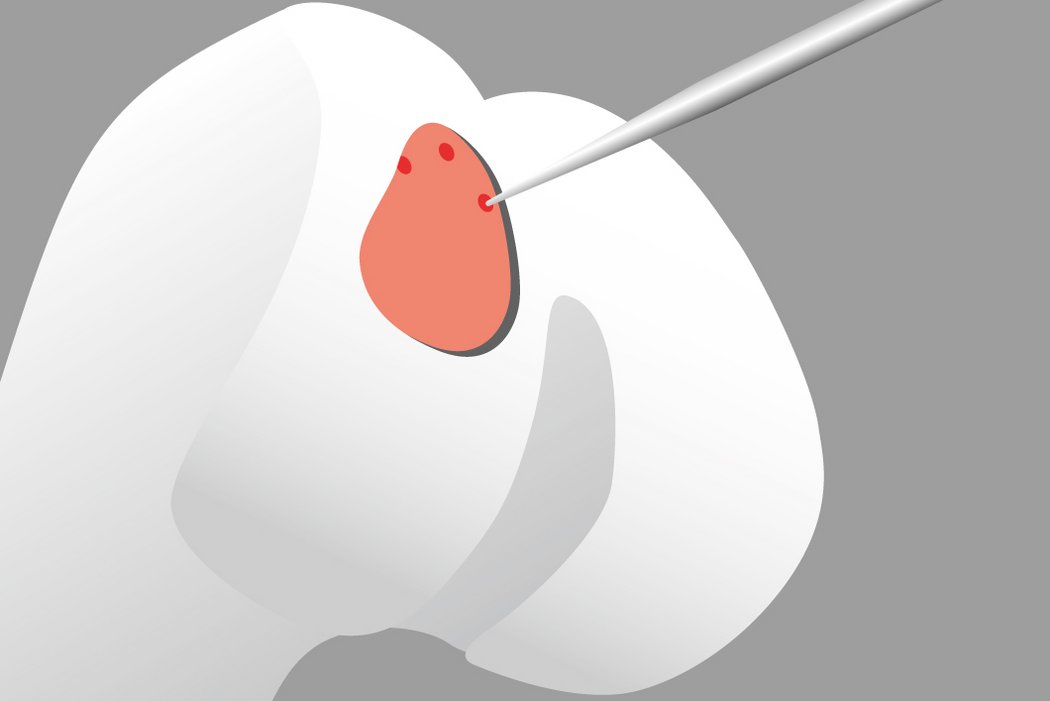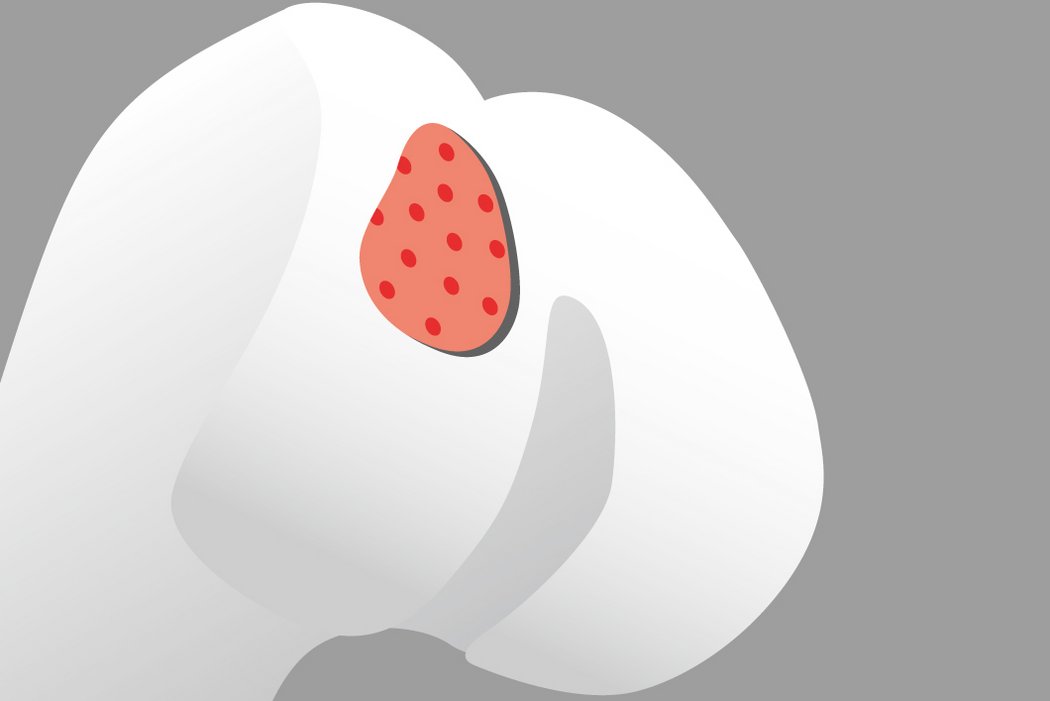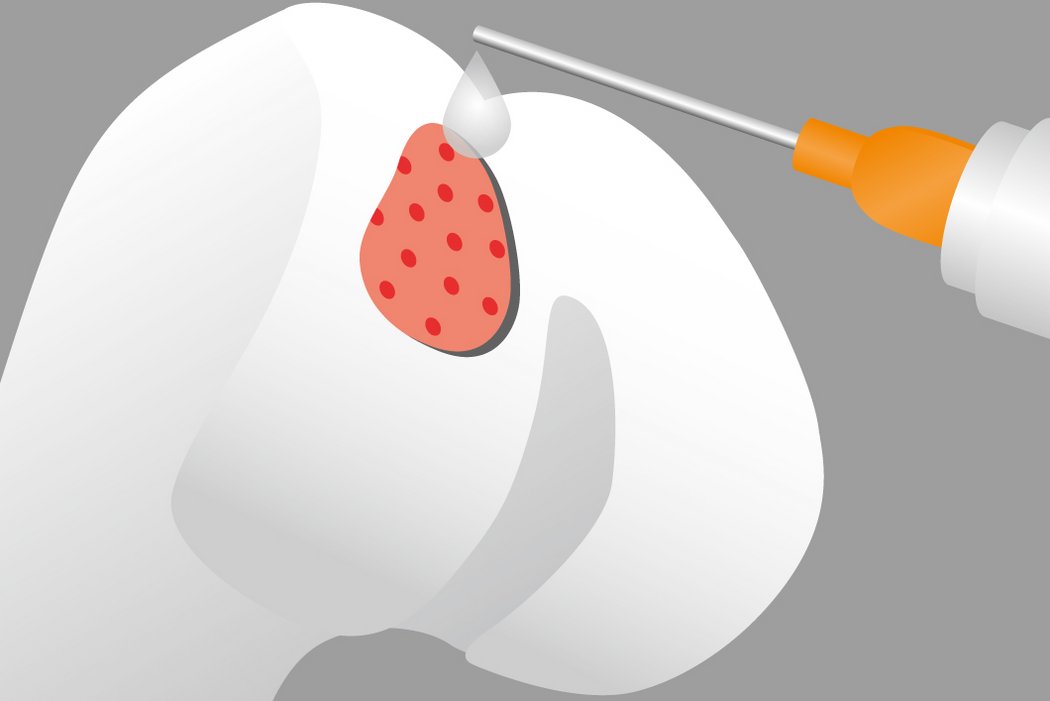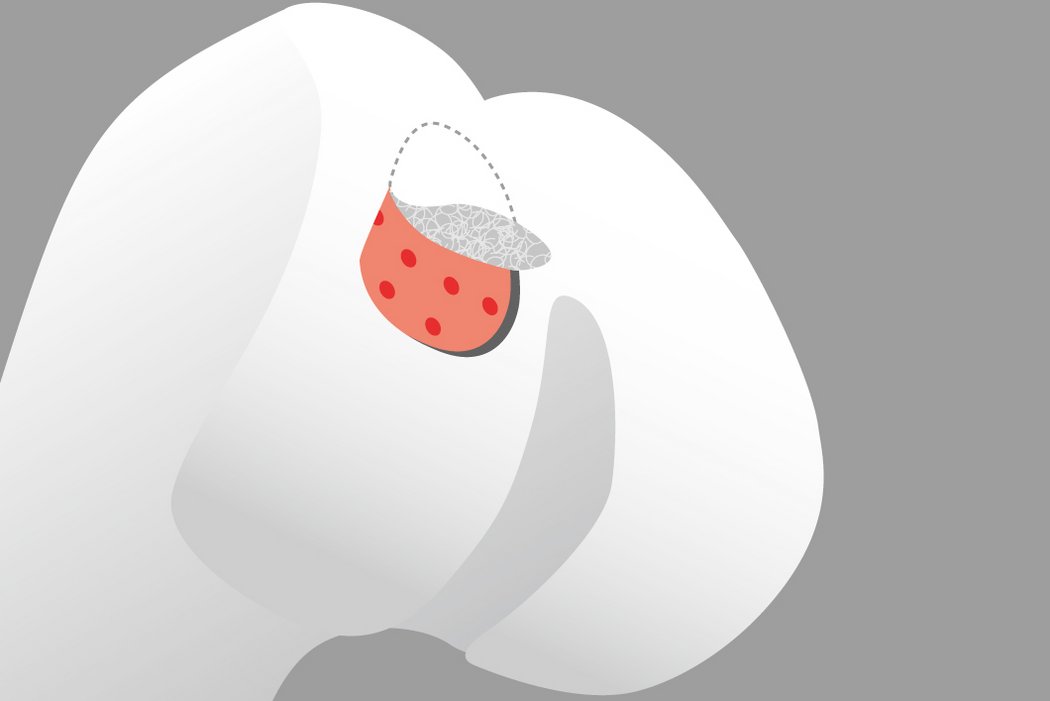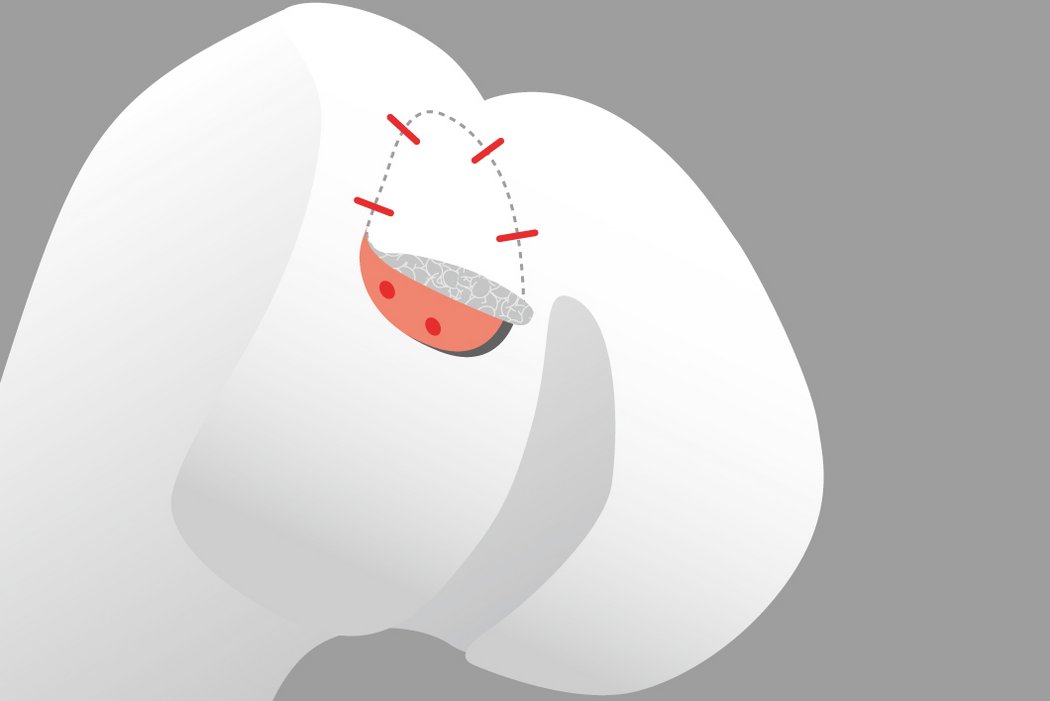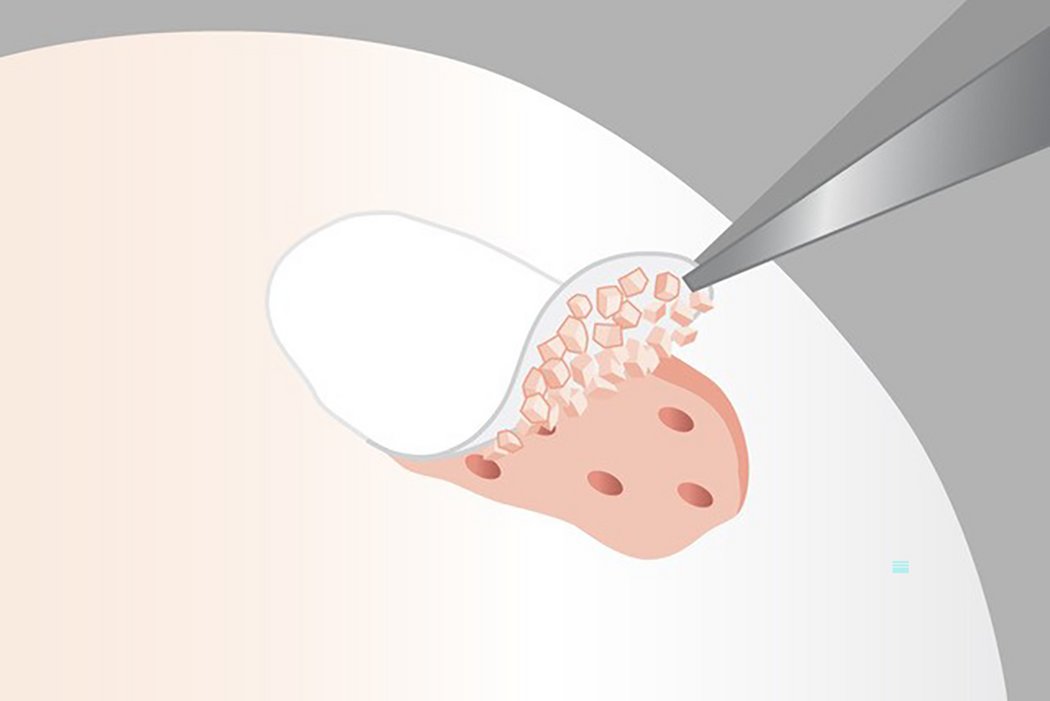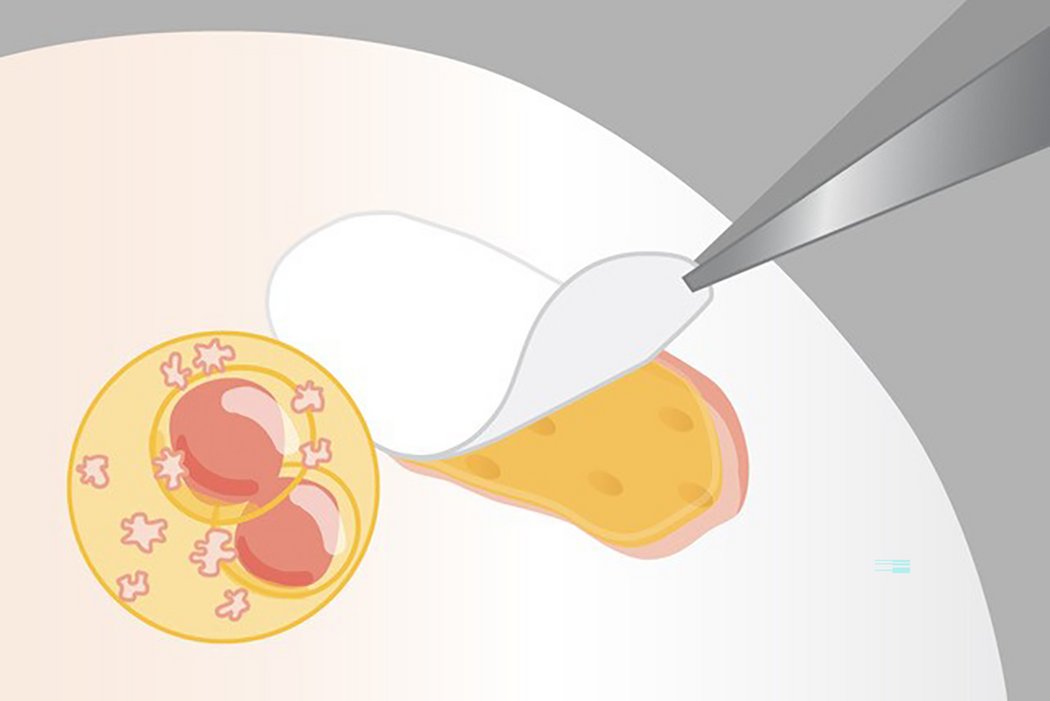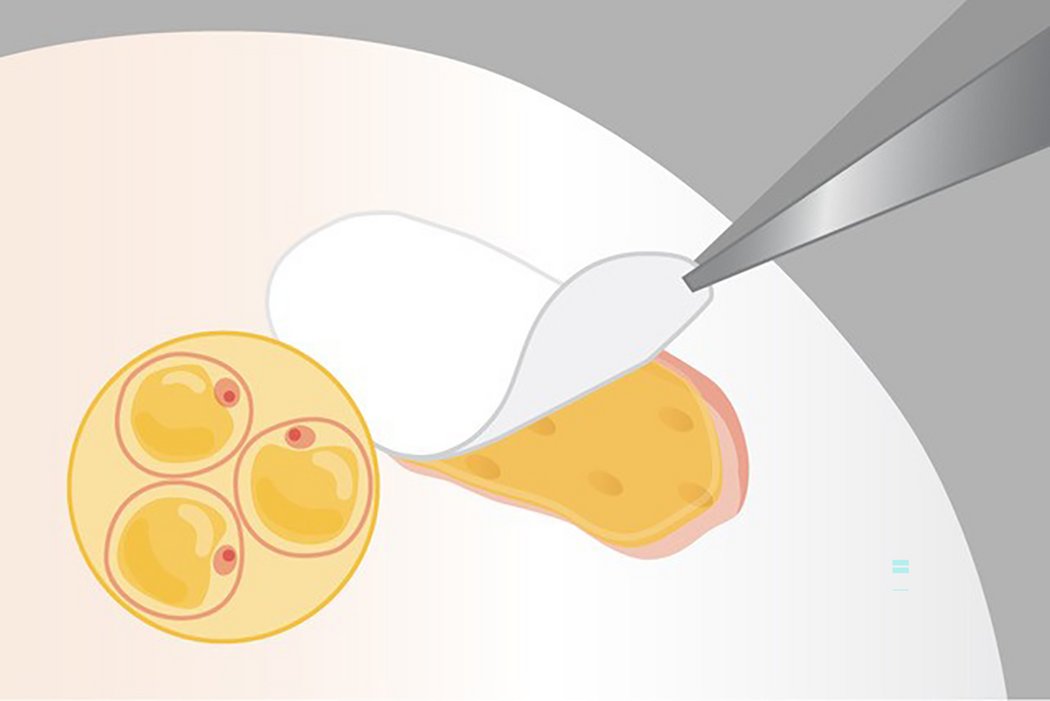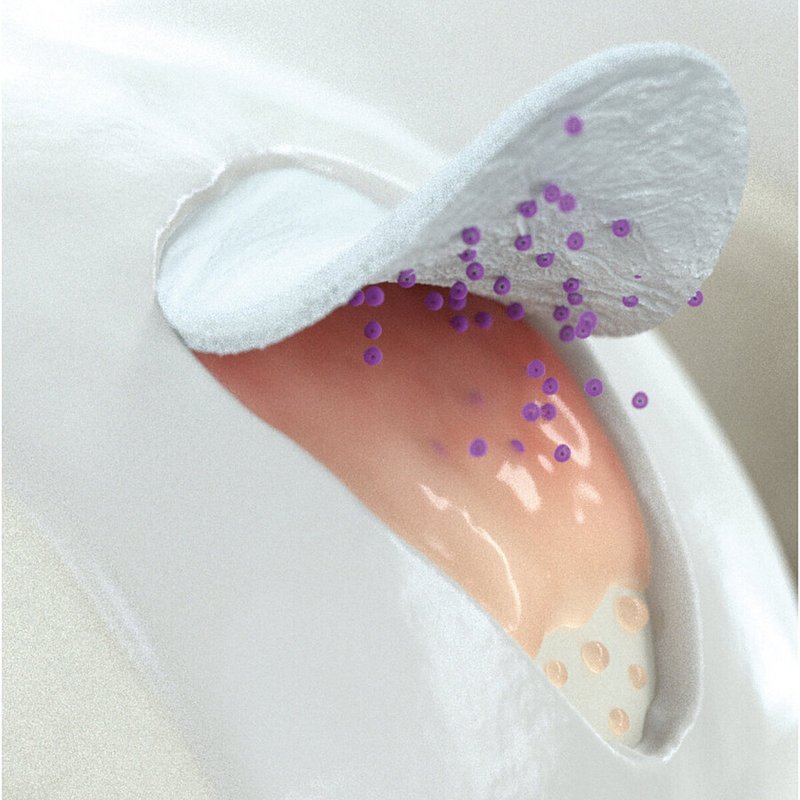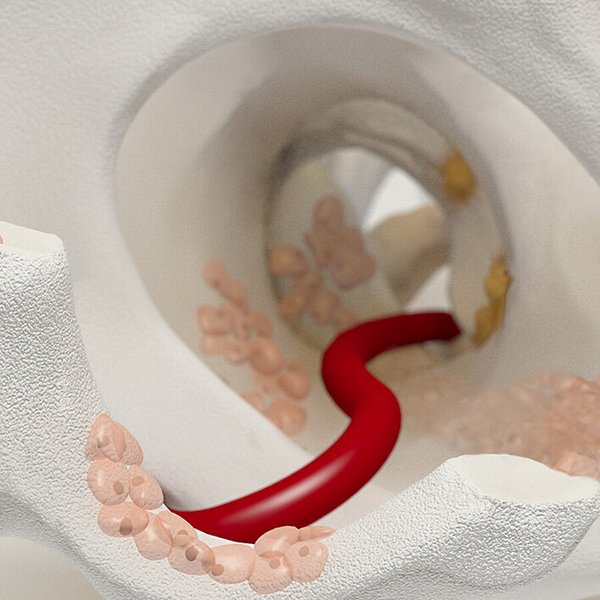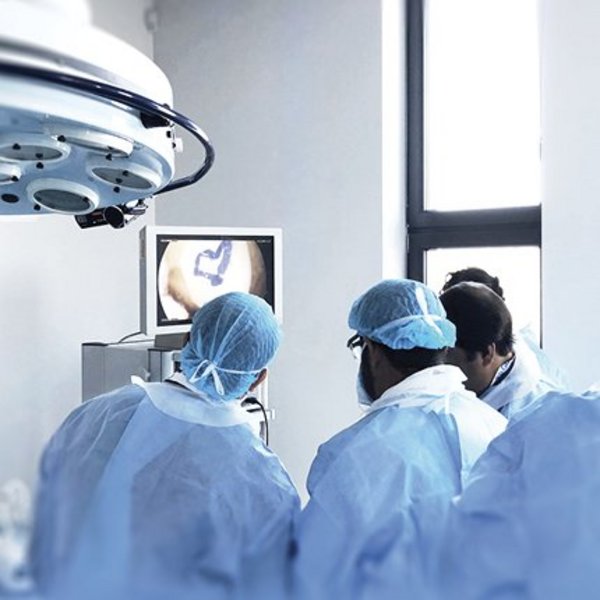AMIC® Chondro-Gide®
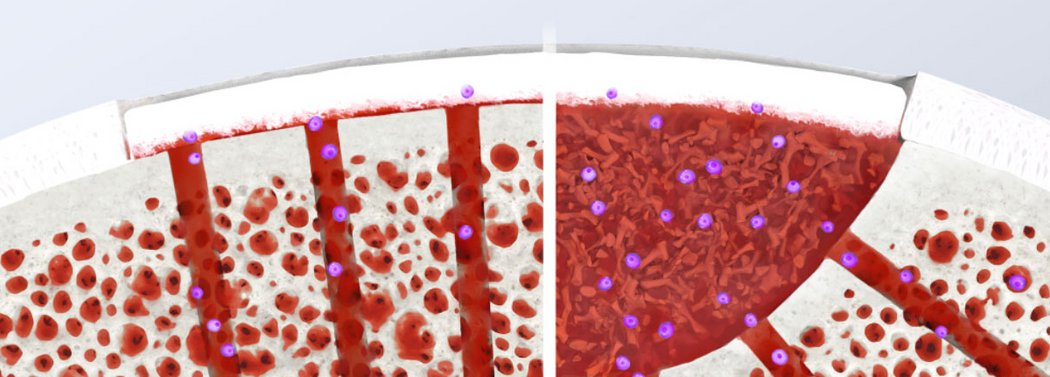
AMIC® Chondro-Gide® è una procedura minimamente invasiva a singolo step che può essere fatta sia in chirurgia mini-open che in artroscopia. Sviluppata da Geistlich Surgery in collaborazione con opinion leaders in Europa, questa tecnica è efficace nella riparazione di difetti condrali e osteocondrali nel ginocchio, astragalo e anca1,2,3.
Vantaggi della tecnica AMIC® Chondro-Gide®
Sia con tecniche artroscopiche che mini-open, il vantaggio di AMIC® Chondro-Gide® è che supporta il potenziale fisiologico di autoguarigione. La cartilagine danneggiata viene rimossa e attraverso tecniche di stimolazione midollare (bone marrow stimulation = BMS) vengono portate nel sito del difetto le cellule necessarie alla rigenerazione.
La membrana copre il difetto e funge da scudo protettivo che contiene le cellule e minimizza l’impatto delle forze sul delicato coagulo. Allo stesso tempo crea una camera biologica sopra il difetto. Il collagene biocompatibile crea un ambiente ideale per la crescita cellulare4 e viene sostituito da nuovo tessuto cartilagineo nel corso del tempo.
References
- VOLZ, M., et al. A randomized controlled trial demonstrating sustained benefit of Autologous Matrix-Induced Chondrogenesis over microfracture at five years. Int Orthop, Apr 2017, 41(4), 797-804) (Clinical study)
- JANELLI, E, et al. Arthroscopic treatment of chondral defects (Clinical study); in the hip: AMIC®, MACI, microfragmented adipose tissue transplantation (MATT) and other options. SICOT J, 2017, 3(43). (Clinical study)
- Geistlich Pharma AG data on file (Bench test)
- GILLE, J., et al. Cell-Laden and Cell-Free Matrix-Induced-Chondrogenesis versus Microfracture for the Treatment of Articular Cartilage Defects: A Histological and Biomechanical Study in Sheep. Cartilage OnlineFirst, January 7, 2010, doi:10.1177/1947603509358721 (Pre-clinical study)
- STEADMAN, J.R., Microfracture Technique for Full-Thickness Chondral Defects: Technique and Clinical Results. Operative Techniques in Orthopaedics. 1997. 7(4), 300-304. (Clinical study)
- STEINWACHS, M.R., et al. Matrix-associated chondroplasty: a novel platelet-rich plasma and concentrated nucleated bone marrow cell-enhanced cartilage restoration technique, Arthroscopy Techniques, 2014, (3) 2, pp e279-e282 (Clinical study)
- RICHTER, M., et al. Matrix-associated stem cell transplantation (MAST) in chondral lesions at the ankle as part of a complex surgical approach- 5-year-follow-up in 100 patients, Foot and Ankle Surgery, Volume 25, Issue 3, June 2019, Pages 264-271 (Clinical study)
- RICHTER, M. et al. Matrix-associated stem cell transplantation (MAST) versus autologous matrix induced chondrogenesis plus peripheral blood concentrate (AMIC+PBC) in chondral defects of the first metatarsophalangeal joint – A clinical cohort analysis." Fuß & Sprunggelenk, 2020, 18(3): 217-226. (Clinical study)
- DE GIROLAMO, L., et al., Autologous Matrix-Induced Chondrogenesis (AMIC) and AMIC Enhanced by Autologous Concentrated Bone Marrow Aspirate (BMAC) Allow for Stable Clinical and Functional Improvements at up to 9 Years Follow-Up: Results from a Randomized Controlled Study. Journal of Clinical Medicine. 2019. Vol. 8, no. 3, p. 392. (Clinical Study).
- GOBBI, A., et al. One-Step Cartilage Repair with Bone Marrow Aspirate Concentrated Cells and Collagen Matrix in Full-Thickness Knee Cartilage Lesions: Results at 2-Year Follow-up. Cartilage, 2011, 2(3): 286-299. (Clinical study)
- GOBBI, A., et al., One-step surgery with multipotent stem cells for the treatment of large full-thickness chondral defects of the knee. Am J Sports Med, 2011 42(3): 648-657. (clinical study)
- MASSEN, F.K., et al. One-Step Autologous Minced Cartilage Procedure for the Treatment of Knee Joint Chondral and Osteochondral Lesions: A Series of 27 Patients With 2-Year Follow-up. Orthop J Sports Med 2019 Jun 13;7(6) (Clinical study)
- SCIARETTA, F.V., One-Step Biological Resurfacing of Osteochondral Defects of the Patella, Novel Surgical Technique, Osteochondral Defects, Sphera Medical Journal, AlphaSigmaGroup, 2016
Sviluppata per supportare la rigenerazione: AMIC® Chondro-Gide®
References:
- VOLZ, M., et al. A randomized controlled trial demonstrating sustained benefit of Autologous Matrix-Induced Chondrogenesis over microfracture at five years. Int Orthop, Apr 2017, 41(4), 797-804) (Clinical study)
- JANELLI, E, et al. Arthroscopic treatment of chondral defects (Clinical study); in the hip: AMIC®, MACI, microfragmented adipose tissue transplantation (MATT) and other options. SICOT J, 2017, 3(43). (Clinical study)
- Geistlich Pharma AG data on file (Bench test)
- GILLE, J., et al. Cell-Laden and Cell-Free Matrix-Induced-Chondrogenesis versus Microfracture for the Treatment of Articular Cartilage Defects: A Histological and Biomechanical Study in Sheep. Cartilage OnlineFirst, January 7, 2010, doi:10.1177/1947603509358721 (Pre-clinical study)
- STEADMAN, J.R., Microfracture Technique for Full-Thickness Chondral Defects: Technique and Clinical Results. Operative Techniques in Orthopaedics. 1997. 7(4), 300-304. (Clinical study)
- STEINWACHS, M.R., et al. Matrix-associated chondroplasty: a novel platelet-rich plasma and concentrated nucleated bone marrow cell-enhanced cartilage restoration technique, Arthroscopy Techniques, 2014, (3) 2, pp e279-e282 (Clinical study)
- RICHTER, M., et al. Matrix-associated stem cell transplantation (MAST) in chondral lesions at the ankle as part of a complex surgical approach- 5-year-follow-up in 100 patients, Foot and Ankle Surgery, Volume 25, Issue 3, June 2019, Pages 264-271 (Clinical study)
- RICHTER, M. et al. Matrix-associated stem cell transplantation (MAST) versus autologous matrix induced chondrogenesis plus peripheral blood concentrate (AMIC+PBC) in chondral defects of the first metatarsophalangeal joint – A clinical cohort analysis." Fuß & Sprunggelenk, 2020, 18(3): 217-226. (Clinical study)
- DE GIROLAMO, L., et al., Autologous Matrix-Induced Chondrogenesis (AMIC) and AMIC Enhanced by Autologous Concentrated Bone Marrow Aspirate (BMAC) Allow for Stable Clinical and Functional Improvements at up to 9 Years Follow-Up: Results from a Randomized Controlled Study. Journal of Clinical Medicine. 2019. Vol. 8, no. 3, p. 392. (Clinical Study).
- GOBBI, A., et al. One-Step Cartilage Repair with Bone Marrow Aspirate Concentrated Cells and Collagen Matrix in Full-Thickness Knee Cartilage Lesions: Results at 2-Year Follow-up. Cartilage, 2011, 2(3): 286-299. (Clinical study)
- GOBBI, A., et al., One-step surgery with multipotent stem cells for the treatment of large full-thickness chondral defects of the knee. Am J Sports Med, 2011 42(3): 648-657. (clinical study)
- MASSEN, F.K., et al. One-Step Autologous Minced Cartilage Procedure for the Treatment of Knee Joint Chondral and Osteochondral Lesions: A Series of 27 Patients With 2-Year Follow-up. Orthop J Sports Med 2019 Jun 13;7(6) (Clinical study)
- SCIARETTA, F.V., One-Step Biological Resurfacing of Osteochondral Defects of the Patella, Novel Surgical Technique, Osteochondral Defects, Sphera Medical Journal, AlphaSigmaGroup, 2016
Sulla base della consolidata tecnica AMIC®, che già include la stimolazione dei processi rigenerativi da parte della BMS, esistono vari approcci per estendere la gamma di fattori biologici utilizzati nel trattamento dei difetti della cartilagine. La gamma di fattori biologici utilizzati finora comprende, ad esempio, il plasma ricco di piastrine (PRP) 6,7,8, l'aspirato/concentrato di midollo osseo (BMA/C)9,10,11, la cartilagine tritata (MC)12 e il tessuto adiposo autologo microframmentato13. Sono stati utilizzati in varie combinazioni con AMIC®.
La possibilità di utilizzare questi componenti biologici aggiuntivi dipende dalle linee guida normative di ciascun Paese.
References
- VOLZ, M., et al. A randomized controlled trial demonstrating sustained benefit of Autologous Matrix-Induced Chondrogenesis over microfracture at five years. Int Orthop, Apr 2017, 41(4), 797-804) (Clinical study)
- JANELLI, E, et al. Arthroscopic treatment of chondral defects (Clinical study); in the hip: AMIC®, MACI, microfragmented adipose tissue transplantation (MATT) and other options. SICOT J, 2017, 3(43). (Clinical study)
- Geistlich Pharma AG data on file (Bench test)
- GILLE, J., et al. Cell-Laden and Cell-Free Matrix-Induced-Chondrogenesis versus Microfracture for the Treatment of Articular Cartilage Defects: A Histological and Biomechanical Study in Sheep. Cartilage OnlineFirst, January 7, 2010, doi:10.1177/1947603509358721 (Pre-clinical study)
- STEADMAN, J.R., Microfracture Technique for Full-Thickness Chondral Defects: Technique and Clinical Results. Operative Techniques in Orthopaedics. 1997. 7(4), 300-304. (Clinical study)
- STEINWACHS, M.R., et al. Matrix-associated chondroplasty: a novel platelet-rich plasma and concentrated nucleated bone marrow cell-enhanced cartilage restoration technique, Arthroscopy Techniques, 2014, (3) 2, pp e279-e282 (Clinical study)
- RICHTER, M., et al. Matrix-associated stem cell transplantation (MAST) in chondral lesions at the ankle as part of a complex surgical approach- 5-year-follow-up in 100 patients, Foot and Ankle Surgery, Volume 25, Issue 3, June 2019, Pages 264-271 (Clinical study)
- RICHTER, M. et al. Matrix-associated stem cell transplantation (MAST) versus autologous matrix induced chondrogenesis plus peripheral blood concentrate (AMIC+PBC) in chondral defects of the first metatarsophalangeal joint – A clinical cohort analysis." Fuß & Sprunggelenk, 2020, 18(3): 217-226. (Clinical study)
- DE GIROLAMO, L., et al., Autologous Matrix-Induced Chondrogenesis (AMIC) and AMIC Enhanced by Autologous Concentrated Bone Marrow Aspirate (BMAC) Allow for Stable Clinical and Functional Improvements at up to 9 Years Follow-Up: Results from a Randomized Controlled Study. Journal of Clinical Medicine. 2019. Vol. 8, no. 3, p. 392. (Clinical Study).
- GOBBI, A., et al. One-Step Cartilage Repair with Bone Marrow Aspirate Concentrated Cells and Collagen Matrix in Full-Thickness Knee Cartilage Lesions: Results at 2-Year Follow-up. Cartilage, 2011, 2(3): 286-299. (Clinical study)
- GOBBI, A., et al., One-step surgery with multipotent stem cells for the treatment of large full-thickness chondral defects of the knee. Am J Sports Med, 2011 42(3): 648-657. (clinical study)
- MASSEN, F.K., et al. One-Step Autologous Minced Cartilage Procedure for the Treatment of Knee Joint Chondral and Osteochondral Lesions: A Series of 27 Patients With 2-Year Follow-up. Orthop J Sports Med 2019 Jun 13;7(6) (Clinical study)
- SCIARETTA, F.V., One-Step Biological Resurfacing of Osteochondral Defects of the Patella, Novel Surgical Technique, Osteochondral Defects, Sphera Medical Journal, AlphaSigmaGroup, 2016
References:
- VOLZ, M., et al. A randomized controlled trial demonstrating sustained benefit of Autologous Matrix-Induced Chondrogenesis over microfracture at five years. Int Orthop, Apr 2017, 41(4), 797-804) (Clinical study)
- JANELLI, E, et al. Arthroscopic treatment of chondral defects (Clinical study); in the hip: AMIC®, MACI, microfragmented adipose tissue transplantation (MATT) and other options. SICOT J, 2017, 3(43). (Clinical study)
- Geistlich Pharma AG data on file (Bench test)
- GILLE, J., et al. Cell-Laden and Cell-Free Matrix-Induced-Chondrogenesis versus Microfracture for the Treatment of Articular Cartilage Defects: A Histological and Biomechanical Study in Sheep. Cartilage OnlineFirst, January 7, 2010, doi:10.1177/1947603509358721 (Pre-clinical study)
- STEADMAN, J.R., Microfracture Technique for Full-Thickness Chondral Defects: Technique and Clinical Results. Operative Techniques in Orthopaedics. 1997. 7(4), 300-304. (Clinical study)
- STEINWACHS, M.R., et al. Matrix-associated chondroplasty: a novel platelet-rich plasma and concentrated nucleated bone marrow cell-enhanced cartilage restoration technique, Arthroscopy Techniques, 2014, (3) 2, pp e279-e282 (Clinical study)
- RICHTER, M., et al. Matrix-associated stem cell transplantation (MAST) in chondral lesions at the ankle as part of a complex surgical approach- 5-year-follow-up in 100 patients, Foot and Ankle Surgery, Volume 25, Issue 3, June 2019, Pages 264-271 (Clinical study)
- RICHTER, M. et al. Matrix-associated stem cell transplantation (MAST) versus autologous matrix induced chondrogenesis plus peripheral blood concentrate (AMIC+PBC) in chondral defects of the first metatarsophalangeal joint – A clinical cohort analysis." Fuß & Sprunggelenk, 2020, 18(3): 217-226. (Clinical study)
- DE GIROLAMO, L., et al., Autologous Matrix-Induced Chondrogenesis (AMIC) and AMIC Enhanced by Autologous Concentrated Bone Marrow Aspirate (BMAC) Allow for Stable Clinical and Functional Improvements at up to 9 Years Follow-Up: Results from a Randomized Controlled Study. Journal of Clinical Medicine. 2019. Vol. 8, no. 3, p. 392. (Clinical Study).
- GOBBI, A., et al. One-Step Cartilage Repair with Bone Marrow Aspirate Concentrated Cells and Collagen Matrix in Full-Thickness Knee Cartilage Lesions: Results at 2-Year Follow-up. Cartilage, 2011, 2(3): 286-299. (Clinical study)
- GOBBI, A., et al., One-step surgery with multipotent stem cells for the treatment of large full-thickness chondral defects of the knee. Am J Sports Med, 2011 42(3): 648-657. (clinical study)
- MASSEN, F.K., et al. One-Step Autologous Minced Cartilage Procedure for the Treatment of Knee Joint Chondral and Osteochondral Lesions: A Series of 27 Patients With 2-Year Follow-up. Orthop J Sports Med 2019 Jun 13;7(6) (Clinical study)
- SCIARETTA, F.V., One-Step Biological Resurfacing of Osteochondral Defects of the Patella, Novel Surgical Technique, Osteochondral Defects, Sphera Medical Journal, AlphaSigmaGroup, 2016
Anche se i componenti biologici e le combinazioni di fattori variano nei nuovi approcci AMIC®+, tutte le tecniche si basano su Chondro-Gide® per mantenere le cellule in posizione e creare una camera biologica che protegge la rigenerazione e supporta il potenziale di guarigione dell'organismo. Gli studi futuri mostreranno se l'aggiunta di uno o più componenti biologici può migliorare la riparazione della cartilagine rispetto al consolidato approccio AMIC®.
References
- VOLZ, M., et al. A randomized controlled trial demonstrating sustained benefit of Autologous Matrix-Induced Chondrogenesis over microfracture at five years. Int Orthop, Apr 2017, 41(4), 797-804) (Clinical study)
- JANELLI, E, et al. Arthroscopic treatment of chondral defects (Clinical study); in the hip: AMIC®, MACI, microfragmented adipose tissue transplantation (MATT) and other options. SICOT J, 2017, 3(43). (Clinical study)
- Geistlich Pharma AG data on file (Bench test)
- GILLE, J., et al. Cell-Laden and Cell-Free Matrix-Induced-Chondrogenesis versus Microfracture for the Treatment of Articular Cartilage Defects: A Histological and Biomechanical Study in Sheep. Cartilage OnlineFirst, January 7, 2010, doi:10.1177/1947603509358721 (Pre-clinical study)
- STEADMAN, J.R., Microfracture Technique for Full-Thickness Chondral Defects: Technique and Clinical Results. Operative Techniques in Orthopaedics. 1997. 7(4), 300-304. (Clinical study)
- STEINWACHS, M.R., et al. Matrix-associated chondroplasty: a novel platelet-rich plasma and concentrated nucleated bone marrow cell-enhanced cartilage restoration technique, Arthroscopy Techniques, 2014, (3) 2, pp e279-e282 (Clinical study)
- RICHTER, M., et al. Matrix-associated stem cell transplantation (MAST) in chondral lesions at the ankle as part of a complex surgical approach- 5-year-follow-up in 100 patients, Foot and Ankle Surgery, Volume 25, Issue 3, June 2019, Pages 264-271 (Clinical study)
- RICHTER, M. et al. Matrix-associated stem cell transplantation (MAST) versus autologous matrix induced chondrogenesis plus peripheral blood concentrate (AMIC+PBC) in chondral defects of the first metatarsophalangeal joint – A clinical cohort analysis." Fuß & Sprunggelenk, 2020, 18(3): 217-226. (Clinical study)
- DE GIROLAMO, L., et al., Autologous Matrix-Induced Chondrogenesis (AMIC) and AMIC Enhanced by Autologous Concentrated Bone Marrow Aspirate (BMAC) Allow for Stable Clinical and Functional Improvements at up to 9 Years Follow-Up: Results from a Randomized Controlled Study. Journal of Clinical Medicine. 2019. Vol. 8, no. 3, p. 392. (Clinical Study).
- GOBBI, A., et al. One-Step Cartilage Repair with Bone Marrow Aspirate Concentrated Cells and Collagen Matrix in Full-Thickness Knee Cartilage Lesions: Results at 2-Year Follow-up. Cartilage, 2011, 2(3): 286-299. (Clinical study)
- GOBBI, A., et al., One-step surgery with multipotent stem cells for the treatment of large full-thickness chondral defects of the knee. Am J Sports Med, 2011 42(3): 648-657. (clinical study)
- MASSEN, F.K., et al. One-Step Autologous Minced Cartilage Procedure for the Treatment of Knee Joint Chondral and Osteochondral Lesions: A Series of 27 Patients With 2-Year Follow-up. Orthop J Sports Med 2019 Jun 13;7(6) (Clinical study)
- SCIARETTA, F.V., One-Step Biological Resurfacing of Osteochondral Defects of the Patella, Novel Surgical Technique, Osteochondral Defects, Sphera Medical Journal, AlphaSigmaGroup, 2016

